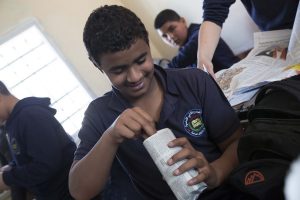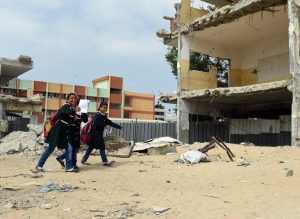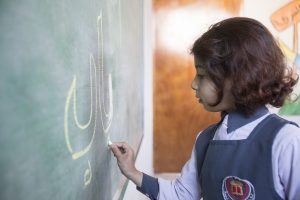Amidst globalization, the accelerating technical revolution, and the ongoing changes in social and economic structures that the world faces every day, nations are seeking to advance and align their education systems in order to incorporate new trends that are emerging regarding knowledge and innovation, and to prepare students to master new challenges. Such efforts are undertaken with and require, no doubt, great investments. The aim of leaders and politicians is to fulfil the aspirations of their people in realizing sustainable development while taking into account the growing competitive environment that persistently requires new competencies and qualifications. We need educational systems that are able to provide current and future generations with the tools and resources that will enable them to dynamically contribute to society, serve humanity, and fulfil their dreams of a better future for themselves and for all.

As Palestinians are striving and preparing for a state of their own, hoping to realize self-determination and peace, the Palestinian government is exerting exemplary efforts in reinforcing its education system and unlocking the potential of its benefits. The government has made huge investments – backed up by the donor community, national and international partners, and the Palestinian private sector and individuals – focusing on increasing the enrolment rate, reducing the dropout rate, and tackling illiteracy, as well as many other considerations. Notwithstanding the protracted occupation and restrictions on development, the government has not only built schools and facilities and improved their infrastructure in order to reduce overcrowded conditions at schools, it has also introduced substantial changes in the education system through far-reaching reforms that focus on improving the system outputs by enhancing the quality of education. Serious efforts have been made towards ensuring quality education through the establishment of specialized labs in technology and science as well as resource centers and libraries. Efforts have been dedicated as well to the improvements of institutional capacity through the development of teachers, supervisors, and councillors, and by curriculum enhancement.
The Palestinian experience is considered to be a model of success among the Arab countries. The National Policy Agenda, with its emphasis on education, sets the national goals and priorities for the investment of resources in the education system that aims to maintain the high rate of enrolment for students in basic education and to make progress towards equitable enrolment in all streams of secondary education, while focusing on the quality and relevance of education.

The students are at the center of this process of fostering knowledge and underpinning life skills while, at the same level of significance, reinforcing the sense of identity and belonging to both a nation and humanity in general. Heading the strategic strides within the scope of enhancing social development and tackling challenges of geographic disparities and multi-dimensional poverty, the national education and higher education strategies frame the priorities for ensuring high-quality education for all without discrimination, linked to the labor market and social needs. Thus, this framework is in line with the global Sustainable Development Goals (SDGs) on education for ensuring inclusive and equitable quality education and promoting lifelong learning opportunities for all.
Regardless of the above, further efforts need to be synergized and focused on reinforcing the education system: provision of new classrooms, with emphasis on Jerusalem and Area C, to cope with the existing and future demands, including early childhood education facilities and improving access for students with special needs, in addition to enhancing quality education and providing institutional support to the Palestinian education system in East Jerusalem. Importantly as well, assistance must be provided in the reconstruction and rehabilitation of school facilities in Gaza, where the planning for eco-friendly schools that address the current scarcity of water and electricity takes on increased urgency.
Much investment in education is planned in order to create an enabling environment for a competent and competitive generation that is able to acquire better jobs, take advantage of emerging employment opportunities, and contribute to national growth and productivity.
Education in East Jerusalem
– There are 87,277 students enrolled in schools, including basic education (grades 1 to 10) and secondary education (grades 11 and 12).
– Approximately 4,300 children are not enrolled in any educational institution.
– Thirty-three percent of children in East Jerusalem fail to complete a full 12 years of schooling.
– Provision of education is fragmented across five different providers: the Palestinian Ministry of Education operating under the Jordanian Islamic Awqaf umbrella, the private sector, the United Nations Relief and Works Agency for Palestine Refugees in the Near East (UNRWA), the Israeli Jerusalem Municipality, and the contractor’s schools that are financed by the Israeli Authorities.
– There is a chronic shortage of classrooms, estimated at around 2,200, with an anticipated annual growth rate of 3 to 4 percent.
– The area available in class for every student is approximately 0.5 square meters, less than the international standards that recommend at least 1.25 square meters.
– Twenty percent of students and teachers and 40 percent of school staff cross a checkpoint on a daily basis to access their schools.
Source: 2016 Jerusalem Directorate of Education Statistics/Geo-mapping Data
But there are major barriers to be overcome, including poor and insufficient school infrastructure in marginalized and underserved localities, limited operational and development fiscal allocations for system sustainability and improvement, and the State of Palestine’s high dependency on donor contributions and assistance. In East Jerusalem, students are subject to discrimination and the disparities of a very weak education system. Education is fragmented among several service providers, school construction is limited in ways similar to other construction activities, and there is a lack of human resource capacities and teachers to run the system in a sustainable manner. In Area C of the West Bank, 24 out of 135 schools are substandard and housed in unsafe spaces; 26 schools face difficulties due to rejected building permits, and planning for school construction is subject to the complicated Israeli zoning and planning rules. In the Gaza Strip, the education system was already overstretched prior to the crisis, suffering from a shortage of almost 200 schools. Now, an estimated 80 percent of Gaza’s schools run on double shifts, seriously jeopardizing the quality of education; around 256 new classrooms are required annually only to absorb the growing student demand, but few schools have been constructed since 2007, mainly due to the blockade and access restrictions on construction materials.

The 50 accredited Palestinian post-secondary and higher education institutions are graduating on average 40,000 students annually – with the unemployment rate among graduates exceeding 53% (e.g. Q1 2017). Despite the efforts made by the government, little progress has been achieved in addressing this crisis. What is required is the inclusion of new strategic directions for effective employment. Technical and Vocational Education and Training (TVET) is considered a valid option, but in order to overcome the low enrolment levels in such training, efforts need to be made in improving access, changing societal perceptions that consider TVET to be a less-desired form of education than that at universities, and better linking TVET with the diverse needs of the labor market.

Since UNDP/PAPP’s inception in 1978, support to the education sector has been a consistent priority, specifically in rural and marginalized communities. Since then, major emphasis has been placed on the development of educational institutions, capacity development for vocational training and higher education, and rehabilitation and expansion of existing schools, with focus on girls as well as ICT, innovation, and arts in education. UNDP/PAPP’s longstanding partnership with the Ministry of Education and Higher Education as well as key development partners in the sector – including the Islamic Development Bank, Norway, Germany through its German Development Bank (KFW), Qatar Fund for Development, and Education Above All Foundation, Government of Japan, Italy, OPEC Fund for International Development, OFID, as well as the governments of Finland, Sweden, and Austria – all contribute to supporting thousands of Palestinian students to access their right to education.


